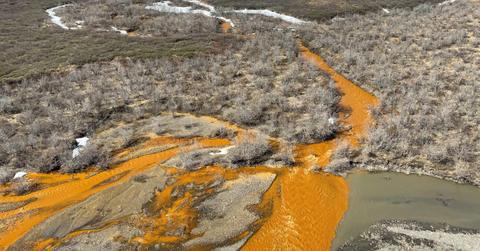Alaska's Arctic Rivers Turning Alarmingly Bright Orange Color, Raising Fears of Ecosystem Disaster

An orange tributary of the Kugororuk River
Dec. 26 2023, Published 1:01 p.m. ET
The pristine arctic rivers of Alaska are experiencing a striking transformation, as their once-clear waters are turning an alarmingly vivid orange hue, prompting concern among scientists.
The phenomenon is particularly pronounced in the Brooks Range, a sprawling 700-mile mountain range extending from northern Alaska into Canada's Yukon Territory. Over the past five to 10 years, at least 75 rivers and streams in this region have taken on a bright orange tint, according to Scientific American.
The leading explanation for the phenomenon points to climate change-induced thawing of permafrost. As per Scientific American, the discoloration results from oxidizing iron and sulfuric acid, indicating elevated concentrations of heavy metals in the rivers. The oxidation of minerals in the soil may also be reducing the water's pH, making it more acidic.
The consequences of the altered pH levels on the intricate river ecosystem remain uncertain, raising concerns among scientists about the potential leaching of toxic metals. This, in turn, could pose a threat to aquatic life and downstream communities that rely on these rivers for sustenance and drinking water.
Becky Hewitt, an environmental studies professor at Amherst College involved in investigating the phenomenon, expressed her concern over the pH issue, emphasizing its alarming nature, as reported by Popular Science.
While scientists have identified the mechanisms behind the rust-colored waters, the specific cause of contamination had been unclear until recently.
An ongoing study is seeking to document these occurrences, their timing and the factors contributing to them by analyzing stream chemistry and testing hypotheses related to their origin.
The United States Geological Survey is overseeing this research, which aims to explore the connections between warming and thawing landscapes, and the potential repercussions for downstream water quality and ecosystems.
- What Lies Beneath: NASA Scientist Believes Aliens May Have Found 'Perfect' Hiding Spot in Earth's Oceans
- Global Threat: Russia Insider Warns West of 'World War Using Nuclear Weapons' Amid Escalating Support for Ukraine
- Countdown to Disaster? Ex-NATO Official Warns Russia, Iran and China Could Wage WWIII in Just Years
The National Parks Service (NPS) emphasized the accelerated warming of the Arctic, outpacing other global regions, with significant consequences for both terrestrial and aquatic ecosystems.
Roman Dial, a researcher and professor of biology and mathematics at Alaska Pacific University, highlighted the severity of the issue, describing affected streams as not only stained but so acidic that they could “curdle your powdered milk,” Popular Science reported.
Never miss a story — sign up for the Front Page Detectives newsletter. Be on the scene the moment news breaks.
Despite initial suspicions of acid mine waste, researchers determined that the rusty discoloration originated from the land itself.
One theory attributes the phenomenon to acid-rock drainage, suggesting that permafrost thaw exposes bedrock, releasing sulfuric acid and iron. Another hypothesis, known as the "wetlands hypothesis," suggests that thaw-activated soil bacteria produce soluble iron, contributing to the rusty color.
Become a Front Page Detective
Sign up to receive breaking
Front Page Detectives
news and exclusive investigations.
